Where to go in Switzerland on a short trip: Alps, lakes, and cities
Switzerland is an extremely popular country for those planning multi-stop tours around Europe, yet very few potential first-time visitors actually know specifically where they want to go. Everyone seems to know that it has the most beautiful views of the Alps and some very impressive cities, but there are actually many misconceptions among casual trip planners, so I’d like to clear most of that up below. The places to visit in Switzerland are not obvious until you’ve been there yourself or done many hours of research, so the list below should be a short cut.
I get hundreds if not thousands of itinerary questions for people who are considering a Eurail trip around Europe, and most people just include the word “Switzerland” among a list of cities like Paris, Rome, and Berlin that they want to visit. So where in Switzerland should you go if you can only make a few stops at most? I’ll answer that question below. You’ll mostly want to focus on the best choices for Swiss Alps trips, which I’ll go over below.
Note: This article was expanded and updated in February, 2024.
Switzerland is about outdoor views rather than city visits
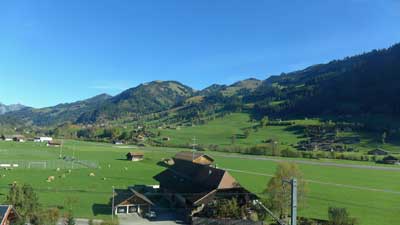
Geneva is a very famous city (though not for tourism reasons) on a lovely lake of the same name, but it’s also notoriously dull and lacking distinction. Rick Steves puts it well by saying that “Geneva is pleasantly situated on a lake, like Buffalo or Cleveland.” The point is, you don’t want to go to Geneva unless you’ve got something specific in mind that you want to see there. There are much better places to visit in Switzerland if your time is limited, or even if it’s not.
Switzerland's cities in summary
Zurich – The largest city, very expensive, geared towards business travelers. It’s generally a pretty and very well-run city that you would enjoy if you visited, but it’s not nearly as interesting as the likes of Vienna, Munich, or of course Paris.
Geneva – Second largest city, in the French part of the country, no major sights. Again, if you visited you’d be very impressed by it and get some great photos, but it’s not worth your time unless you know someone there. There’s an impressive fountain in the lake and you can usually see it from the train as you go through the city, but it’s not really worth going there and staying more than an hour or so.
Basel – Bordering France and Germany, no major sights. It has the famous art market each year, and aside from that it’s even duller than the ones above. Again, if you visited you’d be impressed, but if you later compared photos with friends who went to the Lauterbrunnen Valley instead, you’d kick yourself for going to Basel.
Lausanne – Near Geneva in the French part of the country, very hilly, and certainly more interesting than Geneva.
Bern – The capital, compact, on a lovely river, some interesting sights and the best Swiss city to get a feel for the culture. Bern is fairly close to Interlaken (which we will discuss below) and it can be a great day trip from there, especially on a day where it is foggy and/or rainy in the mountains (and this happens a LOT).
How much time and which Swiss cities to visit?
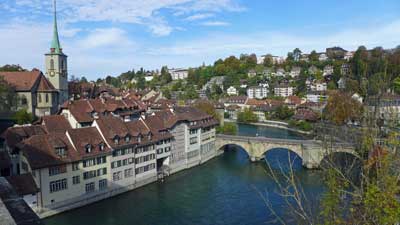
Many people (me included) don’t feel as if they’ve scratched the surface of a new country if they haven’t spent at least a day or two in the largest city. Zurich is certainly pleasant and a useful transit hub so spending one or two nights there wouldn’t be a major mistake. But Zurich isn’t even close to being a city like Paris, Rome, Berlin, Amsterdam, or even Vienna. If you skip it in favor of spending more time in the Swiss Alps, you won’t be missing much.
The 2 Best places to visit in Switzerland for short visits
Interlaken – If you want the best possible Alpine views and activities, head to the Interlaken area, which will be described in detail below. This is my favorite of all places to visit in Switzerland and it will probably be yours as well.
Lucerne – The traditional Swiss tourist retreat, Lucerne is a small city with interesting culture and sights, that is gorgeously set on a lake with plenty of top activities surrounding it.
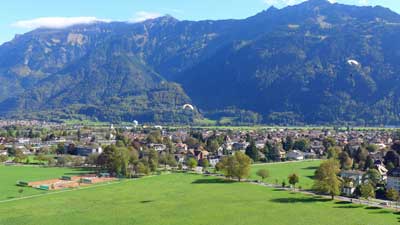
>>>Interlaken and Lucerne: Which to choose and how long to stay in each?
The article linked above will give you more details on which to choose and how long to spend in each place.
What about Zermatt for Alpine views?
Zermatt is a remote car-free village in southern Switzerland that is famous for being the place to see the Matterhorn mountain. It’s also a busy ski resort area, and aside from that, there isn’t much to see or do here. It’s on a private rail line, so it’s more complicated and usually more expensive to reach than Interlaken.
In other words, unless you’ve irrationally placed “Seeing the Matterhorn in person” on your so-called bucket list, skip Zermatt and head to Interlaken on a shorter visit. You won’t be sorry. If you already have enough time in your visit for the main sights around Interlaken and Lucerne and you want to also see the Matterhorn, then by all means go and you’ll enjoy it. There are quite a few other car-free villages in the Lauterbrunnen Valley near Interlaken, so they are not as novel in Switzerland as one might expect.
A weekend in Switzerland? What to see in 3 days
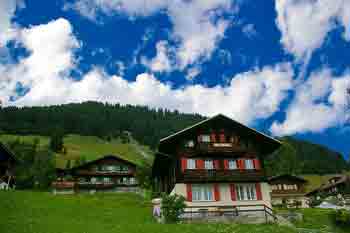
One challenge is that neither has an international airport so you’ll either be flying into Zurich or perhaps Geneva.
Train times from Zurich to Lucerne to Interlaken and back
- Zurich Airport to Lucerne: 1 hour 10 minutes by train
- Lucerne to Interlaken: 2 hours by train
- Interlaken to Zurich Airport: 2 hours 15 minutes by train
As you can see with the travel times above, Zurich Airport to Lucerne is a fairly short trip, but once you add Interlaken into the mix (even if you skip Lucerne) the travel time starts to add up for a weekend visit. With this in mind it’s probably best to just choose one of them and save the other one for another trip.
Lucerne is gorgeous, but the Lauterbrunnen Valley near Interlaken is really the star of the show, so I’d recommend going there first and doing Lucerne on another trip.
What about the Swiss Travel Pass?

The bottom line is that if you are coming to Switzerland for at least 3 days and you want to take 2 or more of the amazing scenic rail journeys that the country is famous for, the travel pass is probably a good deal. It also provides 50% discounts on the Schilthorn cable car and 25% off the Jungfraujoch mountain railway. Both of those are quite expensive on their own, but extremely worthwhile, so the discount is helpful.
The Half Fare Card is probably a better deal for most people
The Swiss Travel Pass is a good deal for those who are going to be spending at least 2 or 3 days riding the rails and seeing Switzerland that way. But if you are mostly going to be focusing on Interlaken and Lucerne and the mountain sights, the Half Fare Card is the best option. For CHF120 (about US$134) you get the card that is good for 30 days and gives you a 50% discount on all trains, cable cars, mountain railways, and other sights and attractions. If you are doing either Schilthorn or Jungfraujoch, the Half Fare Card practically pays for itself with just one of those.
>>>Buy the Swiss Half Fare Card
Many people have questions about the Swiss Half Fare Card so I will explain it a bit here. You can actually buy half price train tickets for travel within Switzerland any time you want and you will see that option when you go to buy them online. The only thing is you have to have and present a valid Half Fare Card when you get on the train and are asked to see your ticket. In other words, you can buy a half fare train ticket today and buy a Half Fare Card just before you get on that train months in the future, and you are fine.
How and why visit the area around Interlaken
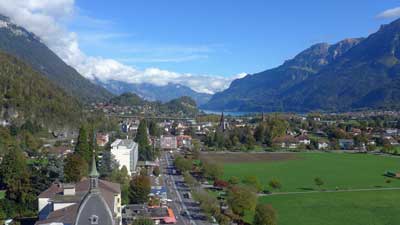
You can see everything discussed below by actually staying in a hotel in Interlaken, but it’s not the Alpine experience that you get if you stay in one of the small villages nearby. You can reach those villages in 20 to 40 minutes from the Interlaken Ost (East) train station, and it’s much easier than it sounds.
The 3 best places to stay to visit the Swiss Alps
Lauterbrunnen – A private train line runs from Interlaken Ost station to the end of its line in Lauterbrunnen. There’s a lovely waterfall here and great hiking trails, but you should probably only stay here if you can’t get to one of the villages mentioned just below. It’s a great little transit hub and it’s definitely gorgeous, so it can be worth a night if you’ve got one to spare.
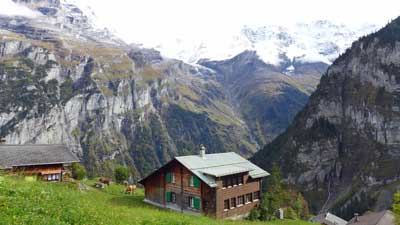
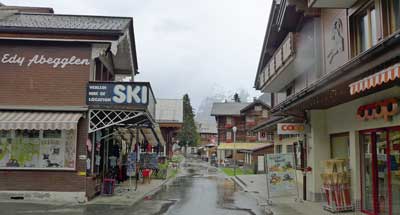
Where to stay in Interlaken and the Lauterbrunnen Valley (with pics)
I get so many questions about where to stay in the Interlaken area that I decided to write a longer version of it and load it with huge photos so readers can get a better feel for each option. I also included recommendations for affordable and well-located photos in each area.
>>>Where to stay in Interlaken and the Lauterbrunnen Valley New for 2024!
The unforgettable things to see here (if the weather is decent)
Schilthorn observation deck and restaurant
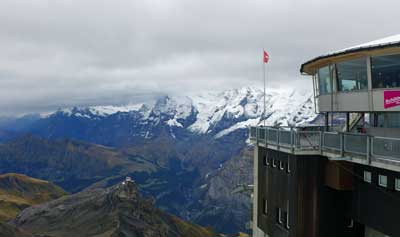
There is a rotating restaurant (with prices similar to normal Swiss restaurants) and a bizarre and anachronistic James Bond attraction based on it being a key location in the 1969 movie On Her Majesty’s Secret Service. The Bond thing is included with the lift, and it’s worth a look.
But the main thing you come here for is the 360-degree view from one of the highest peaks in Europe. Again, the weather here is key, but fortunately all the locals track the visibility on a minute-by-minute basis. If it’s clear up top while you are in the area, it would be a terrible shame to skip it based on the high price. But even if it’s cloudy up top, there are still plenty of wonderful things to see and do in the villages below.
Jungfraujoch observation area
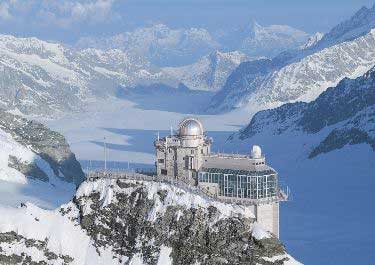
The views from the top are similar to the views from Schilthorn, from the other side of the Lauterbrunnen Valley. Once on top you can have lunch, hike, or even go sledding. It’s also quite expensive at nearly US$200 round-trip unless you have a Swiss Pass or a Eurail Pass for discounts, and it takes most of your day, but you’ll never forget the views from the top.
Harder Kulm mountain and Two Lakes Bridge Observation Deck
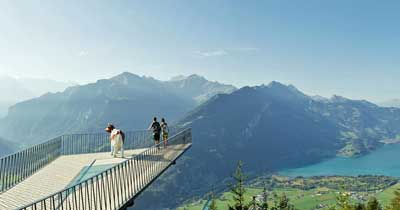
There’s a revolving restaurant about 10 minutes’ walk from the station at the top, which is definitely an unforgettable place for lunch if you’ve got time. It’s not as expensive as you might expect, at least compared to normal restaurants in Switzerland.
The Harder Kulm Railway goes from early April through late November each year. If you are only in Interlaken for one day and/or you are on a strict budget, this is the fastest and best way to get amazing Alpine views in the area.
Getting from Interlaken to Gimmelwald and Mürren
Getting up to these villages sounds complicated and time consuming, but it’s actually fast and easy once you get there. This little guide should help.
Arrive in Interlaken
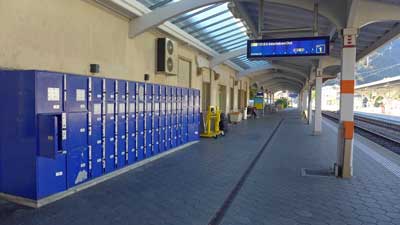
Once you arrive at the Interlaken Ost train station, head for the ticket windows in the office and buy a ticket to your final destination (Lauterbrunnen, Gimmelwald, or Mürren). Eurail passes are good for 25% discounts on the rest of the trip, but not for the whole thing.
From Interlaken Ost to Lauterbrunnen
The private train leaves Interlaken Ost every 30 minutes and arrives in Lauterbrunnen 20 minutes later. If you are staying in Lauterbrunnen then you are probably walking distance from your hotel when you reach the station.
From Lauterbrunnen to Gimmelwald
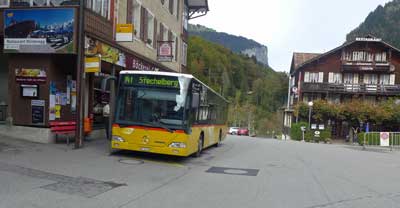

From
Gimmelwald to Mürren
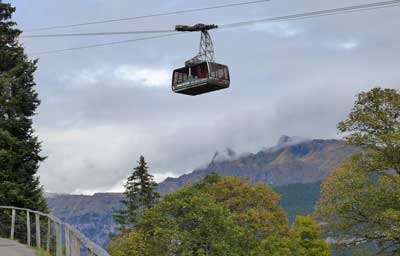
Recommended hotel and hostel in Gimmelwald
I get asked all the time about where to stay in Gimmelwald, so here it is:
Hotel: Esther’s Guesthouse
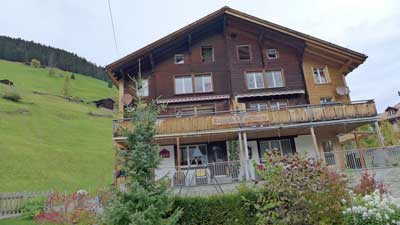
It’s run by Esther, as you might guess, and she is very friendly speaking excellent English. Each room is different and the place feels like a mountain cabin, because it is. She offers an excellent buffet breakfast in the morning, which you have to order the night before. It’s not cheap, but it’s worth it because it’s hearty and there are no other good options nearby.
Book as early as possible because this place is often the first place to sell out in Gimmelwald.
Hostel: Mountain Hostel Gimmelwald
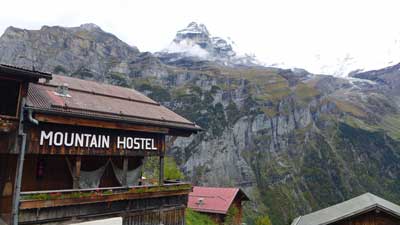
You won’t believe the views from this place, which are the same as from Esther’s except a bit lower and more unobstructed. This place also has a busy bar and restaurant that is basically the only “nightlife” in Gimmelwald. Many hikers get to bed early in this tiny village, but if you want to have a couple drinks and order a pizza or some local options, this is the place to go.
Again, book early because this place is always sold out.
Lucerne and what to do there
Luzern, as it’s spelled locally, is the other traditional holiday destination in Switzerland. Unlike Interlaken, Lucerne actually qualifies as a small city rather than a small resort town, so it’s a very nice contrast and very worthwhile. We have a new article with advice on where to stay in Lucerne and it should be helpful.
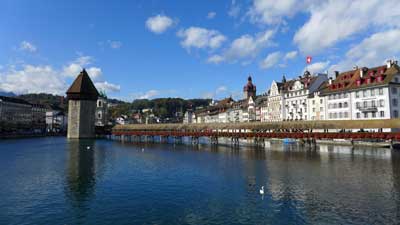
However, unlike Interlaken, the town of Lucerne itself is a great attraction and worth at least a day of exploration. This has always been a rich area so you can expect to find all of the high-end shops and boutiques along the small streets just north of the lake, but there are also many traditional shops and things to see that will appeal to anyone.
Recommended hotel in Lucerne
>>Hotel Des Alpes (3 stars with an amazing location and view)

If this place is booked, which is often the case, then book a hotel as close to it as you can find or afford. The whole historic part of town surrounding it is lovely, with restaurants, bars, and high-end shops. There are also a couple of nearby supermarkets where you can buy inexpensive alcohol and picnic supplies to keep other costs down.
Spend a day in Lucerne itself
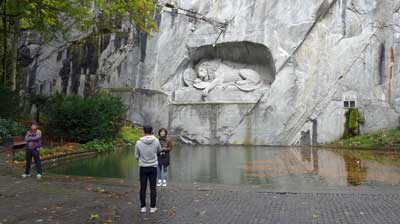
Most of the interesting part of Lucerne is in the area behind those restaurants, and it’s certainly worth doing a self-guided walking tour if not a guided one. Heading farther east you’ll come to another older part of town where the famous lion statue is located. You can’t visit Lucerne without having a look at the lion, and fortunately it’s easy and quick to reach (and it’s free).
Take a lake cruise of some kind
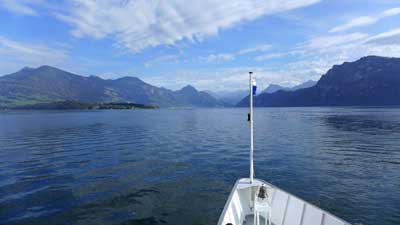
Especially in nice weather, even the short lake tour is lovely, and if you have more time you can jump off at Vitznau and do the scenic hike up Mount Rigi. There are also small lakeside villages that are ideal for a stroll and lunch stop. Long story short, there are dozens of interesting sightseeing options that are available using part of the boat tour, and the views all around are wonderful.
Visit Mount Pilatus
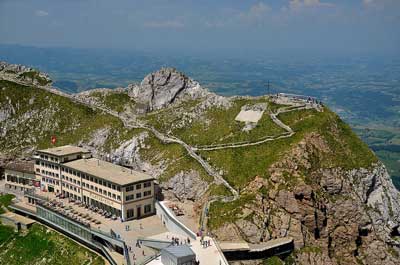
You can take the cogwheel train up and have a more or less flat hike around the summit area, and then take the gondola and cable car back down again. You can do them in the other order, and the cost is the same either way. At around US$65, this is not a cheap hike, but like most everything in Switzerland, the quality is high so it doesn’t feel like a rip-off. You can reach the cable car in 10 minutes on a public trolly bus from Lucerne.
Visit Mount Rigi
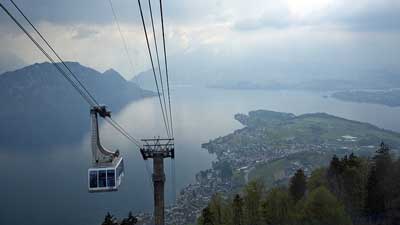
Unlike the other peaks mentioned in this article the Swiss Travel Pass covers both ways to get up and down for free. The others are 50% off with the Swiss Travel Pass or Half Fare Card, except for Jungfraujoch, which is only 25% off with the Swiss Travel Pass and still 50% off with the Half Fare Card.
Visit Mount Titlis
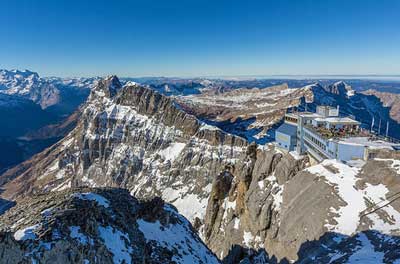
You can reach Titlis by taking a 43-minute train ride from Lucerne to Engelburg and then taking the cable car up from there. As with the others, it’s wise to check the weather immediately before you are going to depart because it can be foggy or cloudy any time of the year, but usually not for whole days at a time.
Additional photo credits
Jungfraujoch by cupweuro on Flickr, Pilatus by Tony Fernandez on Flickr, Rigi by Kosala Bandara on Flickr, Titlis by PaulSchliebs on Flickr

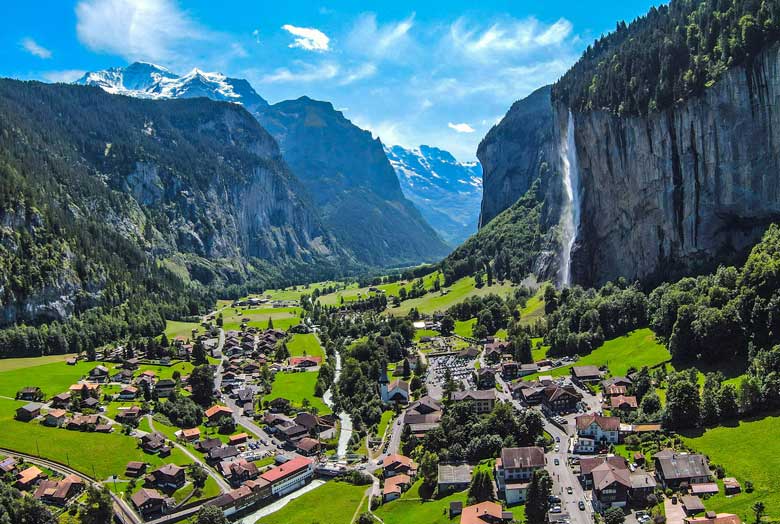
Hi. Am not sure if my post with questions got submitted. Please let me know
Aparna,
I’m not sure how it happened, but I seem to have missed your questions when it first came through. I apologize, and I just wrote a long answer to it. You’ll probably see it a bit up the page. -Roger
Hi Roger,
Your reviews and all the answers above are amazing and full of awesome information! Thank you so much for doing it!!! We just booked a round trip to rome leaving this tuesday for 10 days. we would like to spend about 4 days in Interlaken area. Considering cost and time spent in travel, would you recommend taking a train from rome to Interlaken area, or flying rome-Zurich? and what would be the best way to come back? Also, based on your comments and review above, we’ll definitely stay 1 or 2 nights in Gimmelwald, but where would you recommend to stay the rest of the time? I was thinking about Interlaken or Wengen. We are a couple in 30s and my husband really likes the nightlife, so where would you recommend to stay with the most nightlife available (although I understand it won’t be that crazy in Interlaken area:))
Thank you so much again for all your help! You probably can’t even imagine how helpful it is for us first time travelers!
Olga
Olga,
The fastest train from Rome to Interlaken takes 6 hours 28 minutes, with a change in Milan and another in Spiez. The portion between Milan and Interlaken is one of the world’s most beautiful train rides, so I’d recommend doing it at least once or possibly both ways. If you flew from Rome to Zurich, the train from Zurich Airport to Interlaken takes 2 hours 18 minutes. When you add up all the time of having to be at the airport early and all of that, I think it’s probably faster to take the train anyway. However, it may actually be cheaper to fly. So I’d recommend at least one train ride, or both if the price is similar or the train is cheaper.
When in Gimmelwald you’ll find that the restaurant and bar at the Mountain Hostel has a very friendly nightlife scene (and great pizza). The rest of the time I’d probably stay in Interlaken itself, or maybe Lauterbrunnen if you are going to explore more things that leave from there such as Jungfraujoch. Interlaken is a pretty quiet town, but there are many restaurants and a few bars. Almost all of it is clustered near the two train stations and along the road that connects them. Interlaken Ost (east) is the main transit hub for the area, but there is much more going on closer to the Interlaken West train station, so that’s probably where I’d recommend.
Let me know if you have any other questions. -Roger
Hi Roger,
Thank you so much for your wonderful blog. I was happy to find this .
Planning to cover the places staying only at Gimmelwald. Please let me know if this is a good plan.If not let me know any other options.
Sep 3rd -Interlaken will stay at Gimmelwald Ester House.
Sep 4th -Gimmelwald ,Murren,Schilthorn (NOt sure if we can cover all these places) with walk from Murren to Gimmelwald.
Sep 5th – Jungfrau
Sep6th – Chechkout from Gimmelwald to Zurich .
Please recommend if any changes required.
Jdy,
I’m happy to hear that you find this helpful. Starting from Esther’s House in Gimmelwald, it will take about 50 minutes to reach the Schilthorn observation deck. Even if you spend two hours or so, including lunch at the fantastic Piz Gloria revolving restaurant, you’ll still have plenty of time to get off the cable car in Murren on your way down and eventually stroll down to Gimmelwald. You could do all of that in 5 hours or so, which means you’ll have time to do something else if you care to.
The trip from Gimmelwald to Jungfraujoch will take about 2.5 hours each way, so you’ll have time for something else that day as well. Your plan sounds really good and I’m sure you’ll find other things that interest you to do on all of those days. -Roger
Hi Roger , just can’t thank you enough. I did 90% based on your recommendations and I owe this fab time to you. Lucerne , Schilthorn and Jungfrau.
Hi Roger , based on your blog and inputs , today I did Schilthorn puerlrg based on your recommendation and I must say we all really liked it. As you said we came down from Murren to Gimmelwald and it was such a scenic walk down. Must thank you for your suggestion. Tomorrow off to Jungfrauch !!!
Nawal,
That is fantastic. Thank you for taking the time to mention that. I so rarely hear from people after the planning stage. Schilthorn is amazing on a nice day. -Roger
Hi Roger,
Just reached this article after weeks of searching! I have a couple of weeks off and my boyfriend has one, so we will be visiting family in Annecy until 13 july, and then have max 14-20 (so, a week) to spend in Switzerland. As it is quite expensive, we may do less still.
We love to hike, already visited Torres del Paine and did the W trek in Chile. We also love the sun and having some lakes to swim if the weather allows.
Friends originally advised us to stay in Wilderswil and do the Schynige Platte to First 6h-hike. Now we did not find any suitable accommodation there (it’s all booked, we had no idea summer was also high season!) and so far have only found some possibilities in Frutigen or Burglauenen. Checking your post I did search the places you advice, but there’s only the hostel available. We’re a couple, is it truly worth it for us to go spend a night up there even if in a shared room? Or are there other suitable options? Interesting hikes from there? All help is grealty welcome!
Best,
Jennifer,
There are excellent hikes all over the Alps and other areas in Switzerland as well. That said, I’m more of a sightseer than a “hiker.” In other words, as long as a trail isn’t too steep (going up) and as long as it’s not muddy or slippery, then I mostly focus on the scenery rather than the hike itself. The ones I talk about and have done are suitable for families rather than just those with special boots and maps and such.
If you are referring to the Mountain Hostel in Gimmelwald, I do think it’s special enough to stay there in a dorm if you can pull it off. Read the reviews and you’ll probably be ready to book. From Gimmelwald you can hike up to Murren and then keep going up the mountain all the way to the Schilthorn Observation Deck, but it does get quite steep as you go up from Murren. And there are dozens of notable hikes all around the Lauterbrunnen Valley. In many cases the popular thing is to take a cable car or cogwheel train up, and then hike back down on the gentle trails. I’m not sure if my reply is much help, but I hope it is. -Roger
So kind of you to take time and help other travelers out of your way.
My husband and I are traveling to Switzerland from 7th -12th July (next month). We land 6 am at Zurich on 7th July and leave from Geneva by TGV to Paris on 12th morning (11:40). This gives us 5 nights/5 days completely. Then we stay in Paris for another 5 days.
My queries are regarding the Switzerland stay:
I have a lower back issue and it isn’t possible for me to drag my luggage along and shift hotels by train or cable cars frequently. I am 31 years old and can hike as much as I want but not allowed to lift heavy weights. We love nature and beautiful sight seeing and getting to know some (not all) of the traditional Swiss side is what we are looking for.
1. Does the below itinerary even make sense:
Interlaken – 7th and 8th night until 9th afternoon (Would love to visit a farm, hang around a small village)
Lucern – 9th and 10th night until 11th afternoon (I would love a lake cruise)
Geneva – 11th afternoon to 12th morning and out of here to Paris before noon
2. If we stay at Interlaken, can we do day trips to Gimmelwald/Murren? I really wish to visit them after reading your article. Will the Swiss rail pass suffice or do I have to additionally pay the price of the ticket?
3. Our TGV has been booked from Geneva to Paris. So on the 12th, we need to first go to Geneva. Does this even make sense? Will this technically mean that I move to a Geneva hotel on 11th afternoon and spend the evening there before moving to Paris the next day? Or should I stay in Interlaken or Lucern one more night instead and take an early morning train to Geneva? I am so confused about this. My husband has already done the booking!
4. Do we even need a Swiss Rail pass or can we just buy public train tickets between these towns/cities? If it is going to be scenic enough on all train travel, should I spend additional money on scenic trains over and above? We will be taking the above train rides, cable cars and a few others. Would that mean I should take a Swiss Pass or Half fare card? I am a shopping fanatic and the Paris trip will be burning deep holes in my pockets after this.
5. What would be the weather like? We are from India and we have a short 2 months winter. So, we are not particularly used to lower temperatures or chilly breeze through the days.
P.S: I will have more questions once I firm up the base locations.
Thank you in anticipation
Aparna,
So sorry for missing this question originally. It somehow slipped through.
1. Yes, that plan looks good. There isn’t much to see in Geneva, but it does have a nice location on a lake so you should enjoy it.
2. It’s fast and easy to get to Gimmelwald and Murren from Interlaken. The directions are in the article above, but the short version is that you take a 20-minute train from Interlaken Ost station to Lauterbrunnen. You walk out to the street and you’ll see a bus waiting for you. Get on the bus and 10 minutes later, after passing a tall waterfall, you’ll arrive at the Stechelberg cable car station. Board the cable car and 5 minutes later you’ll be in Gimmelwald. Murren is 5 minutes more up the next cable car from there. It’s probably best to go up to Murren first and then walk down to Gimmelwald for the ride back down. A Swiss Travel Pass will cover all of that, but you should also look into the Half Fare Card, which might be better value for you. I discuss both of them on my main review of the Swiss Travel Pass.
3. One of the many wonderful things about Switzerland is that their trains run famously on time. As long as you book another train to arrive at the Geneva main station by 11:30am or so, you should be fine to catch that train to Paris. Unlike every other country in Europe, it’s extremely rare that Swiss trains are more than a few minutes late. And the trains between cities start early in the morning, usually around 5am. If you have a long train ride from Geneva to Paris in the afternoon, I don’t know if I’d want to take a 3-hour train ride to GET to Geneva, but you don’t have to stay IN Geneva if you don’t want to.
4. As I mention in that Swiss Rail Pass article, it really depends on how many long and scenic train rides you are going to take as to the value you’ll get. The trains in and out of Interlaken are very scenic already. If you take a train or two from there to Lucerne or Geneva, and also the trains and cable cars around Interlaken, you’ll be getting plenty of amazing scenery without having to book a special “scenic” train. In fact, I think every train in Switzerland is scenic, except perhaps for the ones right around Zurich. I think the Half Fare Card is better value for most people, probably including you.
5. The weather should be pleasantly warm in early July in the lower elevations, but it gets colder as you go up in the mountains. There is year-round snow on the highest peaks of the Alps, including around Interlaken. It can also rain in the Alps in summer, although the storms usually only tend to last a few hours before moving on. The standard advice is to pack and dress in layers so you can add or remove clothing as needed.
Let me know if you have other questions, and sorry again for missing this the first time. -Roger
Hi Roger,
So kind of you to take time and help other travelers out of your way.
My husband and I are traveling to Switzerland from 7th -12th July (next month). We land 6 am at Zurich on 7th July and leave from Geneva by TGV to Paris on 12th morning (11:40). This gives us 5 nights/5 days completely. Then we stay in Paris for another 5 days.
My queries are regarding the Switzerland stay:
I have a lower back issue and it isn’t possible for me to drag my luggage along and shift hotels by train or cable cars frequently. I am 31 years old and can hike as much as I want but not allowed to lift heavy weights. We love nature and beautiful sight seeing and getting to know some (not all) of the traditional Swiss side is what we are looking for.
1. Does the below itinerary even make sense:
Interlaken – 7th and 8th night until 9th afternoon (Would love to visit a farm, hang around a small village)
Lucern – 9th and 10th night until 11th afternoon (I would love a lake cruise)
Geneva – 11th afternoon to 12th morning and out of here to Paris before noon
2. If we stay at Interlaken, can we do day trips to Gimmelwald/Murren? I really wish to visit them after reading your article. Will the Swiss rail pass suffice or do I have to additionally pay the price of the ticket?
3. Our TGV has been booked from Geneva to Paris. So on the 12th, we need to first go to Geneva. Does this even make sense? Will this technically mean that I move to a Geneva hotel on 11th afternoon and spend the evening there before moving to Paris the next day? Or should I stay in Interlaken or Lucern one more night instead and take an early morning train to Geneva? I am so confused about this. My husband has already done the booking!
4. Do we even need a Swiss Rail pass or can we just buy public train tickets between these towns/cities? If it is going to be scenic enough on all train travel, should I spend additional money on scenic trains over and above? We will be taking the above train rides, cable cars and a few others. Would that mean I should take a Swiss Pass or Half fare card? I am a shopping fanatic and the Paris trip will be burning deep holes in my pockets after this.
5. What would be the weather like? We are from India and we have a short 2 months winter. So, we are not particularly used to lower temperatures or chilly breeze through the days.
P.S: I will have more questions once I firm up the base locations.
Thank you in anticipation
Hai Roger,
We, a Group of 7, planning to visit Switzerland from 10 Oct to 13 Oct. We will be coming from Paris. We plan to travel from Paris on Oct 9th night. We want to travel out to Florence, Italy by Oct 14th. We are into a budget backpackers trip. Could you suggest us a suitable itinerary? We would like to be in scenic mountain areas like, Interlaken, Gimmelwald, Murren Jungfrauch… We are very much confused in getting a right mode of transport (an economic one) from Paris, and and about the right destination to reach some of the mentioned places. Please help us in sorting out this one with your advice and experience.
Girish,
As for transportation, the train is almost always the best choice, although it’s not very cheap. The thing is, the trains between Paris and Basel and then Basel and Interlaken are very fast and the scenery is great. You might find a bus that is cheaper on part of it, but it will take twice as long and not be nearly as enjoyable. For the international trains, buy 2 to 3 months out for the lowest fares. For trains within Switzerland, they only go on sale 30 days out and the fares are the same no matter when you buy.
If you want to do Jungfraujoch or Schilthorn, or just take train rides and cable cars in Switzerland, then the Half Fare Card (described on the Swiss Travel Pass review article) is the best way to keep your costs down.
As for an itinerary, you get the most scenery in and near the Interlaken area, and Lucerne as well if you have an extra day or two. The cheapest options for 7 people would probably be to book at the Mountain Hostel in Gimmelwald, described in the article above, or rent a house on airbnb. I would think you could find a house that sleeps 7 that would probably be much cheaper than enough hotel rooms.
Regarding the budget, I’m also a budget traveler in most cases, and Switzerland is very challenging for that style. It’s expensive and there are just very few cheap options with anything. Switzerland is also an amazing place and especially with the Half Fare Card you’ll feel like you are getting good value and you’ll never forget the trip. So really, Switzerland is the kind of place that it’s probably better to skip it if you can’t afford trains and hostel beds. Have a great trip. -Roger
Hi Roger,
Like all others have said, thank you so much for your wonderful article. I was so happy to find this and decided to change my entire itinerary based on your reviews (I was thinking to visit only big cities). Anyway, I will travel with my mom (60 years old +) from August 16 – 20 this year. Our itinerary will be:
– Aug 16: Amsterdam – Interlaken (arrive around 19:00) – stay in Interlaken
– Aug 17: Interlaken – Schilthorn – Murren or Gimmerwald – Interlaken – stay in Interlaken
– Aug 18: Interlaken – Lucerne (arrive around 17:00) – stay in Lucerne
– Aug 19: Lucerne
– Aug 20: Lucerne – Zurich (arrive around 12:00)
Zurich – Amsterdam (depart at 17:30)
May i ask how do you think of the itinerary? Is it good for a 60+ person?
The 2nd night, instead of stay in Interlaken, do you recommend us to stay in Murren or Gimmerwald?
My purpose of this trip is to enjoy and admire the Alpes, but also have enough time to relax in between many train rides.
Thank you very much for your time!
Trang
Trang,
I’m happy to try to help. I think your itinerary looks quite good. There should be nothing strenuous or difficult about what you have in mind. I do think that staying at least one night in Gimmelwald (or Murren) is well worth it. Interlaken is a nice town, but those mountain villages have such amazing scenery and provide such a unique experience that I think it’s worth paying a bit more for it. I’m sure you are going to have a wonderful time. Hopefully you won’t encounter much rain or fog in the mountains, which can happen in summer. Keep on top of the weather once you get there and I’m sure you’ll love it. -Roger